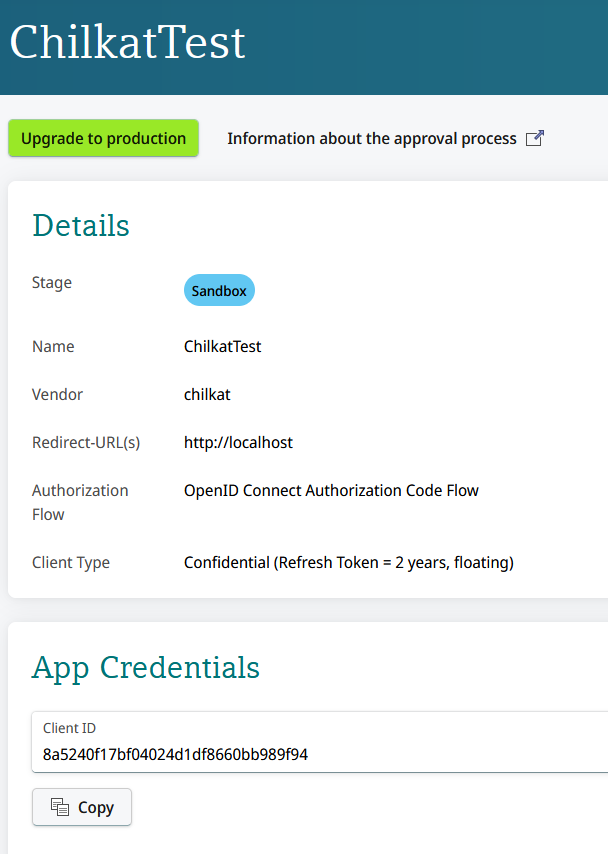|
|
(Delphi ActiveX) Datev OAuth2 Access Token
Demonstrates how to get a Datev OAuth2 access token from a desktop application or script.Note: This example requires Chilkat v10.1.3 or greater.
uses
Winapi.Windows, Winapi.Messages, System.SysUtils, System.Variants, System.Classes, Vcl.Graphics,
Vcl.Controls, Vcl.Forms, Vcl.Dialogs, Vcl.StdCtrls, Chilkat_TLB;
...
procedure TForm1.Button1Click(Sender: TObject);
var
oauth2: TChilkatOAuth2;
url: WideString;
success: Integer;
numMsWaited: Integer;
sbJson: TChilkatStringBuilder;
begin
// To further clarify, see OAuth 2.0 Authorization Flow
oauth2 := TChilkatOAuth2.Create(Self);
// Your Datev app should use "http://localhost" (no trailing forward slash) for the redirect URL.
oauth2.ListenPort := 3017;
//  oauth2.AuthorizationEndpoint := 'https://login.datev.de/openidsandbox/authorize';
oauth2.TokenEndpoint := 'https://sandbox-api.datev.de/token';
// Replace this with your actual client ID.
oauth2.ClientId := 'DATEV_CLIENT_ID';
oauth2.ClientSecret := 'DATEV_CLIENT_SECRET';
oauth2.CodeChallenge := 1;
oauth2.CodeChallengeMethod := 'S256';
oauth2.Scope := 'openid profile email datev:accounting:clients accounting:documents datev:accounting:extf-files-import';
// Begin the OAuth2 authorization code flow. This returns a URL that should be loaded in a browser.
url := oauth2.StartAuth();
if (oauth2.LastMethodSuccess <> 1) then
begin
Memo1.Lines.Add(oauth2.LastErrorText);
Exit;
end;
// Launch the default browser on the system and navigate to the url.
// The LaunchBrowser method was added in Chilkat v10.1.2.
success := oauth2.LaunchBrowser(url);
if (success = 0) then
begin
Memo1.Lines.Add(oauth2.LastErrorText);
Exit;
end;
// Wait for the interactive user to grant permission in the interactive browser session.
// We'll wait for a max of 90 seconds.
numMsWaited := 0;
while (numMsWaited < 90000) and (oauth2.AuthFlowState < 3) do
begin
oauth2.SleepMs(100);
numMsWaited := numMsWaited + 100;
end;
// If there was no response from the browser within 90 seconds, then
// the AuthFlowState will be equal to 1 or 2.
// 1: Waiting for Redirect. The OAuth2 background thread is waiting to receive the redirect HTTP request from the browser.
// 2: Waiting for Final Response. The OAuth2 background thread is waiting for the final access token response.
// In that case, cancel the background task started in the call to StartAuth.
if (oauth2.AuthFlowState < 3) then
begin
oauth2.Cancel();
Memo1.Lines.Add('No response from the browser!');
Exit;
end;
// Check the AuthFlowState to see if authorization was granted, denied, or if some error occurred
// The possible AuthFlowState values are:
// 3: Completed with Success. The OAuth2 flow has completed, the background thread exited, and the successful JSON response is available in AccessTokenResponse property.
// 4: Completed with Access Denied. The OAuth2 flow has completed, the background thread exited, and the error JSON is available in AccessTokenResponse property.
// 5: Failed Prior to Completion. The OAuth2 flow failed to complete, the background thread exited, and the error information is available in the FailureInfo property.
if (oauth2.AuthFlowState = 5) then
begin
Memo1.Lines.Add('OAuth2 failed to complete.');
Memo1.Lines.Add(oauth2.FailureInfo);
Exit;
end;
if (oauth2.AuthFlowState = 4) then
begin
Memo1.Lines.Add('OAuth2 authorization was denied.');
Memo1.Lines.Add(oauth2.AccessTokenResponse);
Exit;
end;
if (oauth2.AuthFlowState <> 3) then
begin
Memo1.Lines.Add('Unexpected AuthFlowState:' + IntToStr(oauth2.AuthFlowState));
Exit;
end;
// Save the full JSON access token response to a file.
sbJson := TChilkatStringBuilder.Create(Self);
sbJson.Append(oauth2.AccessTokenResponse);
sbJson.WriteFile('qa_data/tokens/datev.json','utf-8',0);
// The saved JSON response looks like this:
// {
// "refresh_token": "ZDA5Y .... FFhTXc9",
// "refresh_token_expires_in": 39600,
// "id_token": "eyJ .... Q9w",
// "access_token": "MTM .... 1UDA9",
// "token_type": "bearer",
// "expires_in": 900
// }
Memo1.Lines.Add('OAuth2 authorization granted!');
Memo1.Lines.Add('Access Token = ' + oauth2.AccessToken);
end;
oauth2.AuthorizationEndpoint := 'https://login.datev.de/openidsandbox/authorize';
oauth2.TokenEndpoint := 'https://sandbox-api.datev.de/token';
// Replace this with your actual client ID.
oauth2.ClientId := 'DATEV_CLIENT_ID';
oauth2.ClientSecret := 'DATEV_CLIENT_SECRET';
oauth2.CodeChallenge := 1;
oauth2.CodeChallengeMethod := 'S256';
oauth2.Scope := 'openid profile email datev:accounting:clients accounting:documents datev:accounting:extf-files-import';
// Begin the OAuth2 authorization code flow. This returns a URL that should be loaded in a browser.
url := oauth2.StartAuth();
if (oauth2.LastMethodSuccess <> 1) then
begin
Memo1.Lines.Add(oauth2.LastErrorText);
Exit;
end;
// Launch the default browser on the system and navigate to the url.
// The LaunchBrowser method was added in Chilkat v10.1.2.
success := oauth2.LaunchBrowser(url);
if (success = 0) then
begin
Memo1.Lines.Add(oauth2.LastErrorText);
Exit;
end;
// Wait for the interactive user to grant permission in the interactive browser session.
// We'll wait for a max of 90 seconds.
numMsWaited := 0;
while (numMsWaited < 90000) and (oauth2.AuthFlowState < 3) do
begin
oauth2.SleepMs(100);
numMsWaited := numMsWaited + 100;
end;
// If there was no response from the browser within 90 seconds, then
// the AuthFlowState will be equal to 1 or 2.
// 1: Waiting for Redirect. The OAuth2 background thread is waiting to receive the redirect HTTP request from the browser.
// 2: Waiting for Final Response. The OAuth2 background thread is waiting for the final access token response.
// In that case, cancel the background task started in the call to StartAuth.
if (oauth2.AuthFlowState < 3) then
begin
oauth2.Cancel();
Memo1.Lines.Add('No response from the browser!');
Exit;
end;
// Check the AuthFlowState to see if authorization was granted, denied, or if some error occurred
// The possible AuthFlowState values are:
// 3: Completed with Success. The OAuth2 flow has completed, the background thread exited, and the successful JSON response is available in AccessTokenResponse property.
// 4: Completed with Access Denied. The OAuth2 flow has completed, the background thread exited, and the error JSON is available in AccessTokenResponse property.
// 5: Failed Prior to Completion. The OAuth2 flow failed to complete, the background thread exited, and the error information is available in the FailureInfo property.
if (oauth2.AuthFlowState = 5) then
begin
Memo1.Lines.Add('OAuth2 failed to complete.');
Memo1.Lines.Add(oauth2.FailureInfo);
Exit;
end;
if (oauth2.AuthFlowState = 4) then
begin
Memo1.Lines.Add('OAuth2 authorization was denied.');
Memo1.Lines.Add(oauth2.AccessTokenResponse);
Exit;
end;
if (oauth2.AuthFlowState <> 3) then
begin
Memo1.Lines.Add('Unexpected AuthFlowState:' + IntToStr(oauth2.AuthFlowState));
Exit;
end;
// Save the full JSON access token response to a file.
sbJson := TChilkatStringBuilder.Create(Self);
sbJson.Append(oauth2.AccessTokenResponse);
sbJson.WriteFile('qa_data/tokens/datev.json','utf-8',0);
// The saved JSON response looks like this:
// {
// "refresh_token": "ZDA5Y .... FFhTXc9",
// "refresh_token_expires_in": 39600,
// "id_token": "eyJ .... Q9w",
// "access_token": "MTM .... 1UDA9",
// "token_type": "bearer",
// "expires_in": 900
// }
Memo1.Lines.Add('OAuth2 authorization granted!');
Memo1.Lines.Add('Access Token = ' + oauth2.AccessToken);
end;
|

